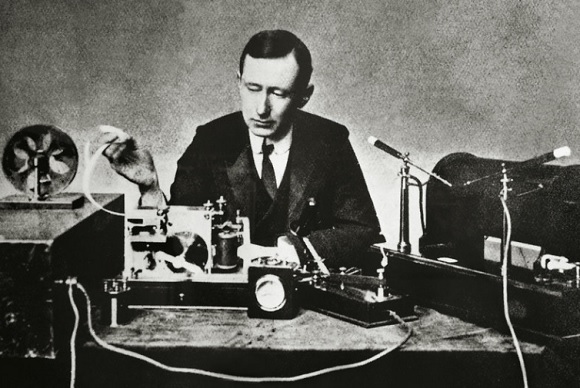It’s easy to think that the modern era in communication began in the 1990s with the birth of the Internet.
But we actually have to go back further — to 1895 and the discovery that intelligible signals could travel through the “air” without a wired connection.
A hundred years before Facebook and Microsoft, Google and Apple, an Irish-Italian precursor laid the foundation for today’s wireless, mobile communication culture. Like today’s tech moguls, Guglielmo Marconi was heavily contested by some of his rivals. Like them, he rose above the fray by sheer determination, as well as talent, luck and vision. But more than any of today’s icons — more than Bill Gates, Steve Jobs, Mark Zuckerberg and the rest — Marconi was uniquely at the center of the communication revolution of his time.
Marconi was the first person to use radio waves to send information. In his mind, he was developing an improvement on the dominant technology of the day, the wired telegraph; using Morse code, Marconi called what he was doing “wireless telegraphy.” This captured the imagination because it meant people were no longer cut off from their homes and businesses while traveling at sea — a transatlantic crossing could take a week or more in 1896, when Marconi’s wireless first appeared.
Voice came later, as did shortwave, radar and direction positioning. Marconi was at the centre of each of these developments. Marconi’s invention meant that, for the first time, communication reached where wires could not go. He foresaw a world where one day, as he put it in 1919, “a passenger flying in an aeroplane over France or Italy might ‘ring up’ a friend walking about the streets of London with a receiver in his pocket…”

Guglielmo Giovanni Maria Marconi, Italian physicist and inventor, with one of his first wireless telegraphs. (Photo: A. DeGregorio/Getty Images/DeAgostini)
The first uses for wireless were military. By 1901, Marconi had a contract with the British navy, which used his system in the Anglo-Boer War in South Africa. He would do business with anyone. His system was used by the King of the Belgians in the Congo, Europe’s most murderous African colony. He serviced both sides in the 1904-05 Russo-Japanese War, enabling him to write to his mother: “The War between Russia and Japan has brought a good deal of money to the Company and things are looking very well.” At the same time, in public declarations, he always insisted that wireless was an instrument of peace.
But Marconi’s research was what drove him. His overriding ambition was to conquer distance and, in December 1901, he stunned the world when he announced, in Newfoundland, that he had received a signal from England. It was a single letter in Morse Code, three dots signifying the letter “s.” There were doubters, but two months later he was in regular contact with his station in Cornwall while crossing the Atlantic, with the ship’s captain as his witness.
By December 1902, he was able to send complete messages between England and America. A commercial service for ordinary consumers could now be envisaged. Wireless telegrams — or “marconigrams” as they were soon known — could be sent for around one-tenth the cost of a cable. This was a boon especially for the new waves of diasporic populations who now had a cheap way of keeping in touch with home.
Marconi used the courts to make sure that no one else would be able to build on his “fundamental” patent. For a while, the strategy worked. But he became too big, too powerful, too strong, and between 1903 and 1906 the German emperor, determined that wireless not be in the hands of a British company, successfully led an international move to prevent him from getting a global monopoly.
Click here for full article
Source: http://www.npr.org/

